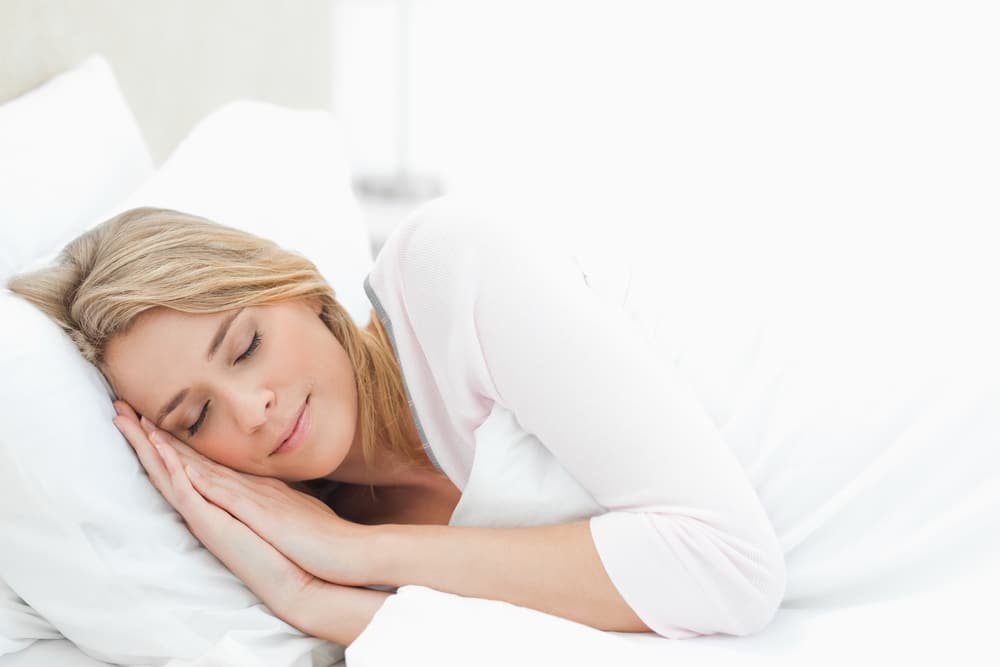Body temperature plays an important role in well-being. Getting too warm can signify a fever, while getting too cold can cause bodily systems to shut down. This balance is also important for sleep: if your body isn’t at the right temperature before bed, you may be too uncomfortable to dip into a peaceful slumber.
Learn how to sleep better by optimizing your environments for sleep. Knowing the best temperature for sleep (and creating a bedroom that meets that standard) is one of the best sleep hacks out there.
Here’s what experts have to say about the ideal temperature for restful sleep.
The Best Temperature for Sleep
Being too warm can cause restlessness, and being too cold can lead to muscle contractions and blood vessel constriction, all of which create insomnia. So how should you set your thermostat to ensure the best sleep possible?
According to The National Sleep Foundation, a cool room around 65 degrees Fahrenheit provides the best sleep for most people. However, the average body temperature can vary depending on your age and overall health.
Babies and toddlers, for example, need the room to be between 65 and 70 degrees to sleep well. Women of different ages and even during different times of the month might need more variations, such as a slightly colder than average room, as hormonal changes — for example ovulation — can elevate their normal body temperature.
Body Temperature and Sleep
Your body temperature directly influences your ability to sleep. Why? Because body temperature decreases in response to going to bed. “When you go to sleep, your set point for body temperature — the temperature your brain is trying to achieve — goes down,” Stanford University’s H. Craig Heller, PhD told WebMD.
The deepest phase of sleep, also known as slow-wave deep sleep or non-rapid eye movement (NREM) sleep, occurs in correlation with a drop in brain and core temperatures.This is why decreased body temperature leads to drowsiness, and increased body temperature makes us feel more alert (like when we’re exercising).
It’s also why the right bedroom temperature is so important. When you wake up during the night due to uncomfortable conditions, you decrease the amount of NREM and REM sleep your body receives. We need NREM sleep for whole-body restoration, brain detoxification, and REM sleep is crucial for learning and memory consolidation.
The Role of Sleep Disorders and Other Conditions
Natural changes in body temperature are referred to as thermoregulation, according to sleep expert Dr. Michael Breus. He points out that thermoregulation is part of the circadian rhythm, the 24-hour sleep cycle that keeps us awake during the day and resting when the sun goes down.
However, temperature regulation can be influenced by other factors, such as illness, medications, menopause, pregnancy, and sleep disorders such as sleep apnea. These can greatly affect both REM (rapid eye movement) sleep and deep sleep. Experiencing these circumstances can cause frequent waking throughout the night, lowering sleep quality and reducing your ability to perform well in everyday life.
But, according to Breus, better sleep can be achieved even when faced with hormone disturbances or sleep disorders. In fact, making a few changes to your environment and routine can help reset your internal thermostat to an ideal sleeping temperature.
Sleep Tips for Better Rest
Now that you understand how the body responds to temperature, you can work toward creating the optimal environment for a good night’s sleep. If you’re constantly hitting snooze when the alarm goes off, it might be time to consider how you can adjust your bedroom surroundings to achieve the rest your body needs.
Adjusting for Climate
No one wants to wake up with night sweats, yet setting the air conditioner to its lowest level can make the room too cold for comfort. If you’re someone who prefers the cold side of the pillow, you know how important it is to avoid overheating during the night.
One way to find a happy medium is to use a fan, which can make a room up to 10 degrees cooler. Using this method reduces energy costs and prevents you from getting too warm throughout the evening.
The most important thing to remember is that comfort is key. Think of your bedroom as a cave — it should be cool, dark, and most of all, quiet.
Bedding and Mattresses
Your bedding is another important aspect of your sleep environment. For example, memory foam pillows and mattresses tend to trap heat and make you feel warmer, especially if you’re a stomach sleeper. One idea is to opt for moisture-wicking sheets that keep you cool during sleep. Cotton sheets tend to be breathable, and some pillows are made with cooling materials that promote airflow.
On the other hand you can opt for a gel mattress or a gel mattress mat to place over your memory foam mattress.
If you share a bed with someone else, a larger bed can prevent the transfer of body heat throughout the night, thereby reducing overheating.
These simple changes, in combination with maintaining a cool room, can help you maintain an optimal temperature and sleep better throughout the night.
Sleep Habits and Routines
Regulating your body temperature may seem difficult during warmer months, especially if you tend to wake up feeling too warm. One effective — and seemingly counterintuitive — method is to take a warm bath or shower 60-90 minutes before bedtime.
A warm bath positions your body for a cool down once you step out of the bathroom. This kickstarts the cooling cycle that makes your body feel drowsy before bedtime, helping you fall and stay asleep.
Doing this every night can get your body into a routine so that it associates a shower in the evening with the onset of drowsiness. Similarly, drinking a warm cup of tea can warm your body and promote the cooling process so that you feel sleepy before bedtime.
The Best Temperature for Sleep
Finding the ideal sleeping temperature for your body is an important factor for a good night’s sleep. However, there are several more puzzle pieces at play when it comes to creating the ideal sleep environment. Climate, bedding, and nighttime routines all contribute to when you fall asleep — and how well you rest throughout the night.
Taking control of these matters by learning more about your sleep patterns, can ensure that you don’t miss out on a restorative night of sleep. Your quality of sleep is directly affected by your body temperature, bed room environment, and night-time routine, so taking actions to optimize them is important for your health, longevity, and happiness.
How do you know if your sleep routine and bedroom environment is helping you sleep better? By measuring the quality of your sleep, of course. With Biostrap’s standard sleep tracking feature, you’ll gain valuable insights into your sleep quality, from the amount of light and deep sleep you get to time spent in bed as well as sleep latency and nocturnal awakenings, and more. In addition to that, the Biostrap Sleep Lab subscription provides even more comprehensive details including circadian rhythm analysis and individualized bed time recommendations.
Sleep is when the body resets, restores, recovers and performs several vital regulatory processes, so once you start sleeping like a pro, you will wake up with the energy and motivation you’ve always wanted.



